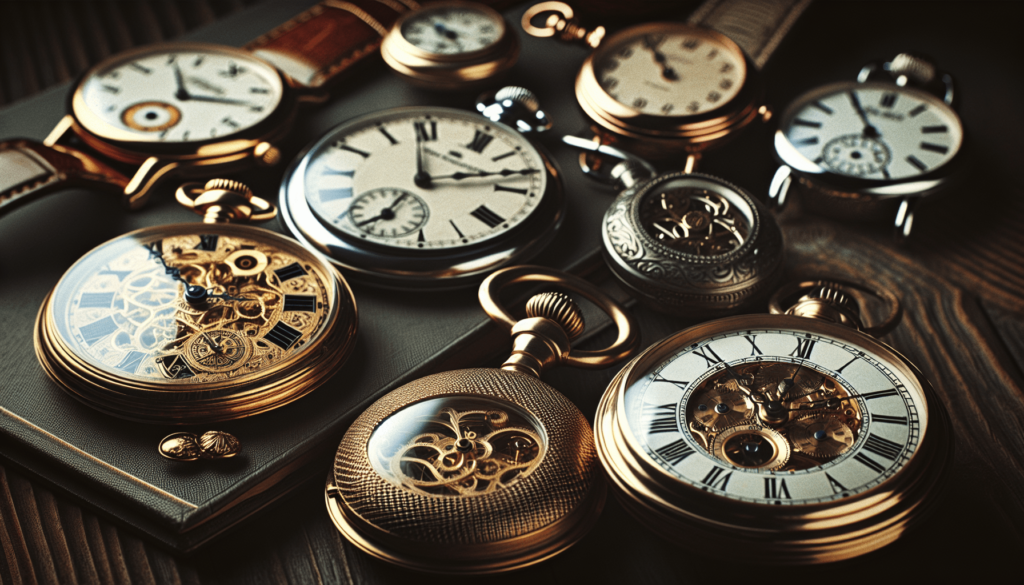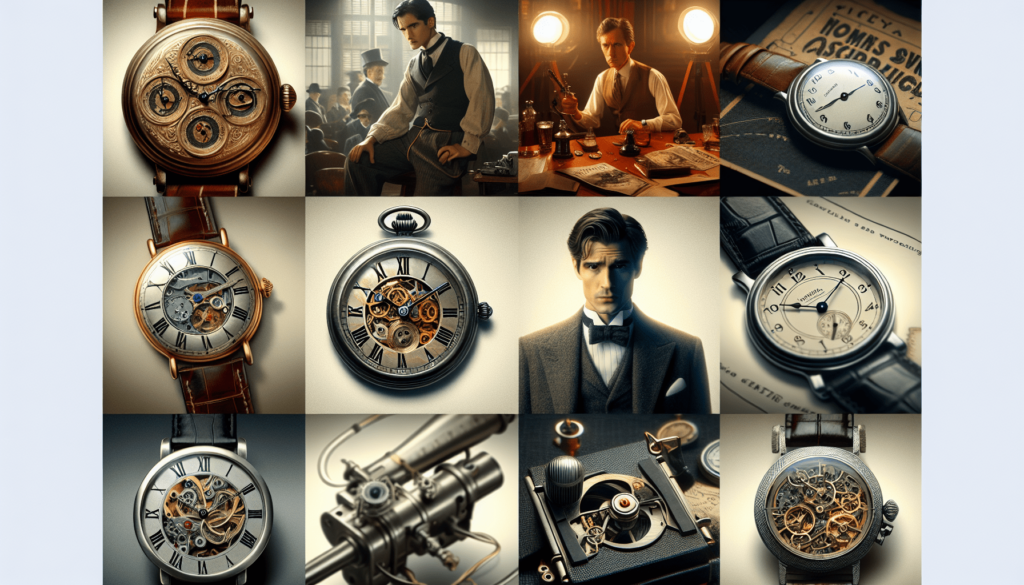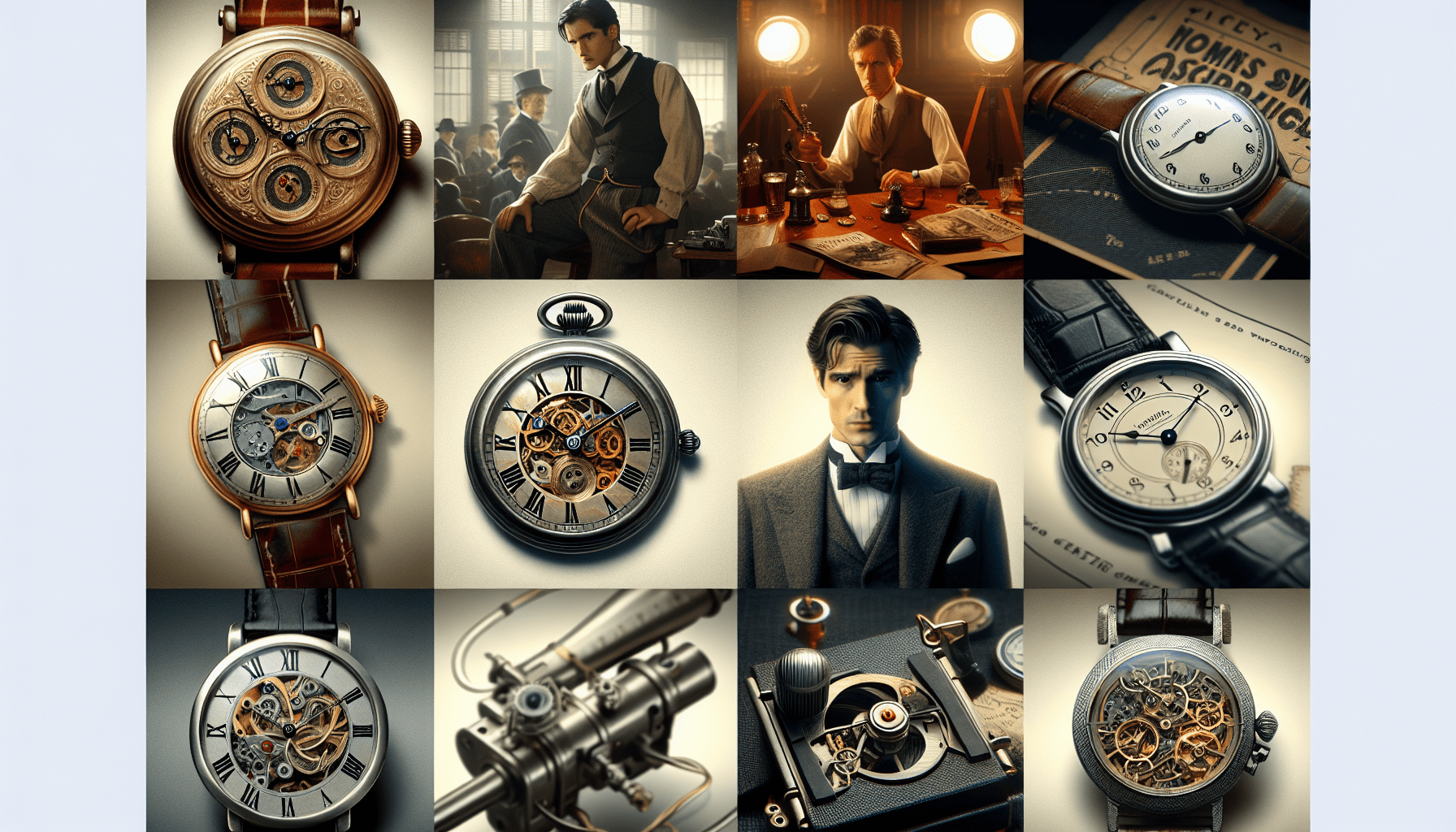Step into the fascinating world of film and television with a captivating exploration into the history of historical watches. From classic timepieces, like those seen in iconic films such as “Casablanca” and “Breakfast at Tiffany’s,” to the cutting-edge smartwatches featured in modern blockbusters, this article takes you on a journey through the evolution of watches on the silver screen. Discover how these timekeeping devices have not only played a crucial role in storytelling but also become symbols of style, character development, and even plot devices. Join us as we delve into the rich history of historical watches in film and television!

Early Depictions of Watches in Film
Silent Films
In the early days of film, watches were often used as a plot device to create tension or move the story forward. Silent films relied heavily on visual storytelling, so watches became a useful symbol for conveying the passage of time. For example, a close-up shot of a pocket watch being wound up and ticking away could indicate that a crucial moment is approaching. Watches were also frequently used in comedic scenes, with characters comically struggling to read the time or having their watches constantly malfunctioning.
Early Talkies
With the advent of sound in film, watches took on a new role as both a visual and auditory cue. Directors could now use the sound of a ticking watch to heighten suspense or build tension in a scene. The ticking of a watch could create an unsettling atmosphere during a dramatic moment, or signal the imminent arrival of an important event. Additionally, characters in early talkies often relied on watches for practical purposes, such as setting meeting times or coordinating plans, further emphasizing the importance of watches in plot development.
Role of Watches in Plot Development
Symbolism
Watches have long been associated with the passage of time and the fleeting nature of life, making them a powerful symbol in film and television. A watch can serve as a reminder of mortality, emphasizing the urgency and importance of the story being told. In some cases, the presence or absence of a watch can represent a character’s preparedness or lack thereof, adding another layer of symbolism to the narrative.
MacGuffin
In certain films, a watch may play the role of a MacGuffin, a plot device that drives the story forward and motivates the characters. The watch becomes an object of desire, pursued by various characters throughout the film. The quest for the watch becomes the central focus, leading to thrilling chase sequences, unexpected alliances, and intense conflicts. The value placed on the watch within the story elevates its significance and makes it a crucial element in plot development.
Countdown
Watches are often used to create a sense of urgency or impending doom through countdown sequences. Whether it’s a bomb timer ticking down or a race against time to accomplish a mission, watches help to build suspense and keep audiences on the edge of their seats. The constant reminder of the dwindling time adds a layer of intensity to the narrative, and the characters’ reliance on their watches heightens the stakes of their actions.
Famous Watches in Film and Television
James Bond’s Rolex Submariner
One of the most iconic watches in film history is the Rolex Submariner worn by James Bond. In the early Bond films, the Rolex Submariner became synonymous with the character and symbolized Bond’s sophistication, style, and resourcefulness. The watch’s durability and water resistance also reflected Bond’s ability to handle any situation. The Bond franchise established a strong association between watches and the suave, adventurous nature of the spy genre.
Marty McFly’s Casio CA53W
In the beloved Back to the Future trilogy, Marty McFly’s digital Casio CA53W watch became an emblem of the 1980s and a symbol of his technological adeptness. The futuristic design and advanced features of the watch captured the imagination of audiences, while its importance to the plot as a timer added tension and a sense of urgency. Marty’s watch highlighted the intersection of fashion, technology, and storytelling, making it an iconic timepiece in both film and popular culture.
Tony Stark’s Jaeger-LeCoultre Reverso
Tony Stark, the charismatic billionaire and superhero in the Marvel Cinematic Universe, is often depicted wearing the Jaeger-LeCoultre Reverso. This luxury watch represents Stark’s wealth and refined taste, perfectly complementing his extravagant lifestyle. The Reverso’s unique reversible case design also symbolizes Stark’s ability to adapt and transform himself, mirroring his character arc throughout the films. As a collectible timepiece, the Reverso adds a touch of elegance and sophistication to Stark’s on-screen persona.
Watches as Fashion and Status Symbols
Influencing Watch Trends
Film and television have a significant impact on fashion trends, and watches are no exception. When a popular character or celebrity is seen wearing a particular watch on screen, it often leads to increased demand and popularity for that brand or style. Audiences are inspired by the fashion choices of their favorite characters, and the watch industry continues to capitalize on this influence by collaborating with filmmakers and incorporating their watches into the narrative.
Product Placement
The inclusion of watches in film and television is also driven by product placement deals between watch brands and production studios. Watch manufacturers recognize the value of having their timepieces showcased on-screen, as it serves as a powerful marketing tool. By strategically placing their watches on the wrists of beloved characters, brands can gain exposure to millions of viewers, creating brand recognition and potentially driving sales.
Celebrity Endorsements
Celebrities and influential figures often serve as brand ambassadors for watch companies, further enhancing the association between watches and status. When a celebrity is seen wearing a particular watch off-screen, it elevates the brand’s desirability and prestige. This symbiotic relationship between watches and celebrities creates a sense of aspiration and exclusivity, as fans strive to emulate the style and sophistication of their favorite stars.

History of Watch Brands in Film and Television
Omega
Omega watches have had a long and illustrious history in film and television. The brand’s association with the James Bond franchise began in 1995 with the release of “GoldenEye.” Since then, Omega has become synonymous with the iconic spy character, with subsequent Bond films featuring various models from their collection. Omega’s reputation for precision and reliability aligns perfectly with Bond’s character traits, solidifying their partnership as a match made in horological heaven.
Rolex
Rolex is another watch brand that has left an indelible mark on the world of film and television. Known for its timeless design and exceptional craftsmanship, Rolex timepieces have been prominently featured in numerous films spanning different genres. From the iconic Submariner worn by James Bond to the classic Datejust seen on the wrists of influential characters, Rolex watches have become synonymous with luxury and refined taste in the world of cinema.
Seiko
Seiko watches have made their mark in film and television through their innovative designs and technological advancements. In the 1980s, Seiko gained widespread recognition for their digital watches, particularly through their collaborations with the “Back to the Future” franchise. The futuristic aesthetics of Seiko’s timepieces perfectly complemented the film’s time travel narrative, solidifying the brand’s status as a pioneer in watch technology and design.
Accuracy and Anachronisms
Historical Inaccuracy
While watches in film and television often help to create an immersive and believable world, there may be instances of historical inaccuracy. Filmmakers may take creative liberties with the time period in which a story is set, introducing watches that were not yet invented or were not commonly used during that era. While these inaccuracies may be overlooked by casual viewers, watch enthusiasts and historians may scrutinize such details for accuracy and historical integrity.
Intentional Anachronisms
In some cases, intentional anachronisms may be introduced to inject a sense of style or quirkiness into a film or television series. Watches that do not match the time period of the story can serve as a deliberate artistic choice, adding an element of visual interest and juxtaposition. These intentional anachronisms are often used to emphasize the timeless quality of a story or to create a unique aesthetic that sets the production apart from traditional period pieces.
Role of Watch Experts
To ensure accuracy and authenticity, filmmakers may consult with watch experts and historians during the production process. These experts provide valuable insights into the historical context of watches, helping to maintain consistency and accuracy in the portrayal of timepieces on-screen. Their expertise ensures that the watches chosen for a film or television series are appropriate for the time period, enhancing the overall believability and immersion of the narrative.
Watches as Character Development Tools
Style and Personality
The choice of watch worn by a character can speak volumes about their style and personality. A sleek and modern timepiece may indicate a character’s contemporary taste and sophistication, while a vintage watch with patina and character can evoke a sense of nostalgia or a connection to the past. The design, brand, and condition of a watch provide subtle visual cues to audiences, helping to convey information about a character’s tastes, socioeconomic background, and even their attention to detail.
Timepieces as Family Heirlooms
In some instances, watches are used to symbolize a character’s familial connections and personal history. A watch passed down through generations can become a cherished family heirloom, representing tradition, legacy, and the passage of time. These timepieces serve as emotional touchstones and can carry deep sentimental value for both the characters in the story and the audience watching it unfold. The presence or absence of a family watch can reveal insights into a character’s values, relationships, and personal journey.
Technological Advancements in Watch Props
Miniature Mechanisms
Throughout the history of film and television, watch props have become increasingly sophisticated thanks to advancements in miniature mechanical engineering. Filmmakers collaborate with skilled artisans to create custom-made watches specifically designed for a production. These watch props often have functional mechanisms and intricate details, adding an extra layer of authenticity to the on-screen portrayal of timepieces.
Special Effects
In more fantastical genres, watches may be enhanced with special effects to create visually stunning and otherworldly timepieces. The use of CGI (Computer-Generated Imagery) enables filmmakers to manipulate the appearance of watches, turning them into magical artifacts or devices with extraordinary capabilities. These special effects allow watches to transcend their physical limitations and become integral parts of the larger narrative, enhancing the overall visual spectacle of the film or television series.
Cultural Significance of Watches in Film and Television
Representing Time
At its core, the presence of watches in film and television serves as a visual representation of time itself. Watches are tangible objects that anchor the characters in a specific moment, reminding them of the limited nature of existence and the importance of making every second count. By prominently featuring watches on-screen, filmmakers can foster a deeper appreciation for the preciousness and fleeting nature of time in both the narrative and the lives of the audience.
Depictions of Masculinity
Watches have historically been associated with masculinity, representing attributes such as reliability, precision, and efficiency. In film and television, watches are often worn by male characters as a symbol of their strength, authority, and sophistication. Properly chosen timepieces can convey a character’s sense of style and enhance their overall aura. From the suave charm of James Bond to the calculated genius of Tony Stark, watches play an integral role in shaping our perception of male characters in the cinematic and televisual landscape.
Symbolizing Wealth
Watches have long been associated with wealth and social status, both in real life and on-screen. In film and television, watches worn by affluent characters serve as clear indicators of their financial success and social standing. Luxury timepieces are often chosen to underscore a character’s opulence, refinement, and access to a privileged lifestyle. These watches become markers of wealth, creating aspirational figures for audiences and helping to build the world of the story.
Watch Collecting Inspired by Film and Television
Limited Edition Releases
The inclusion of watches in film and television has led to the creation of limited edition releases by watch brands. When a watch becomes iconic through its association with a popular character or franchise, watch manufacturers may collaborate with filmmakers or actors to release limited production runs of the timepiece. These exclusive releases generate excitement and collector frenzy, as die-hard fans and watch enthusiasts seek to own a piece of cinematic history.
Collector’s Market
Watch collecting has become a popular pastime for enthusiasts around the world, and film and television have played a significant role in fueling this passion. When a beloved character or celebrity is seen wearing a particular watch on-screen, it often becomes highly sought after in the collector’s market. The desirability and rarity of these timepieces create a thriving secondary market, with collectors willing to pay a premium to own a piece that holds both horological and cultural significance.
In conclusion, watches have played a multifaceted role in the history of film and television. From being crucial plot devices and status symbols to influencing fashion trends and inspiring watch collecting, timepieces have contributed to the visual language and storytelling techniques of the medium. As audiences continue to be captivated by the magic of cinema and television, watches will undoubtedly remain an integral part of the on-screen narrative, showcasing their timeless appeal and cultural significance.

